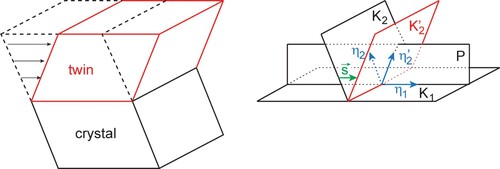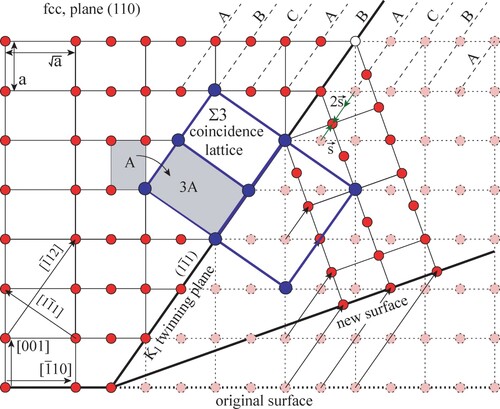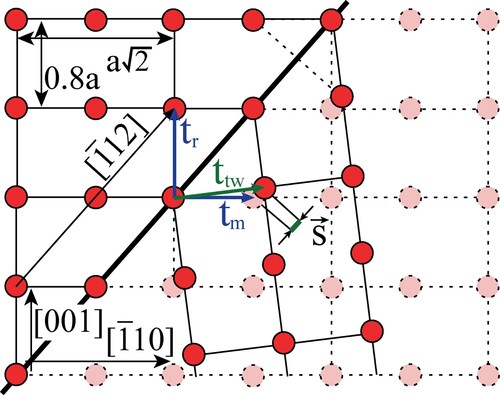Figures & data
Figure 3. (a) Result of shearing by in fct lattice, c/a = 0.8. The same positions of atoms can be reached also by shearing in the opposite direction by the vector
. (b) Result of mirroring the crystal along the
plane in fct lattice, c/a = 0.8.
![Figure 3. (a) Result of shearing by s→=1/6[1¯12] in fct lattice, c/a = 0.8. The same positions of atoms can be reached also by shearing in the opposite direction by the vector s′→. (b) Result of mirroring the crystal along the (11¯1) plane in fct lattice, c/a = 0.8.](/cms/asset/bac825c5-7022-43c9-b0ca-6758de4ba578/tphm_a_2135037_f0003_oc.jpg)
Figure 4. Parameters f and f ‘ as a function of ratio r = c/a. Magnitude of the vector is the unity of the y-axis.
![Figure 4. Parameters f and f ‘ as a function of ratio r = c/a. Magnitude of the [1¯12] vector is the unity of the y-axis.](/cms/asset/8b43e0b7-e19e-4684-b33b-f1d98c215b53/tphm_a_2135037_f0004_oc.jpg)
Figure 5. The generalised planar fault energies γ (GPFE) of (a) Al, (b) In, (c) TiAl, (d) Ni2FeGa as a function of ratio (the ratio of shear displacement
and Burgers vector
. The structures in each subplot display from left to right the perfect lattice, the intrinsic stacking fault, and two- and three-layer twins. The dashed arrows correspond to the minima of non-optimised GPFE whereas solid arrows represent the minima of fully optimised GPFE. If only solid arrow is shown, both minima coincide.
![Figure 5. The generalised planar fault energies γ (GPFE) of (a) Al, (b) In, (c) TiAl, (d) Ni2FeGa as a function of |s→|/|b→| ratio (the ratio of shear displacement s→ and Burgers vector b→=1/6[1¯12]). The structures in each subplot display from left to right the perfect lattice, the intrinsic stacking fault, and two- and three-layer twins. The dashed arrows correspond to the minima of non-optimised GPFE whereas solid arrows represent the minima of fully optimised GPFE. If only solid arrow is shown, both minima coincide.](/cms/asset/c5606412-beb0-4fc6-ad6a-a17fce6036a9/tphm_a_2135037_f0005_oc.jpg)
Table 1. Experimental and ab initio lattice parameters a and c/a and magnitude of Burges vector , shearing vector
, ratio
, and factor f calculated from ab initio lattice parameters. The experimental data were taken from the following works: Al [Citation71]; In [Citation72]; TiAl [Citation73]; Ni2FeGa [Citation43].
Table 2. Energies of intrinsic stacking fault γisf, two-layer twin γ2t and three-layer twin γ3t in mJ/m2 and corresponding ratio of vectors and
for non-optimised and fully-optimised structures.
Data availability
Data will be made available on request.



